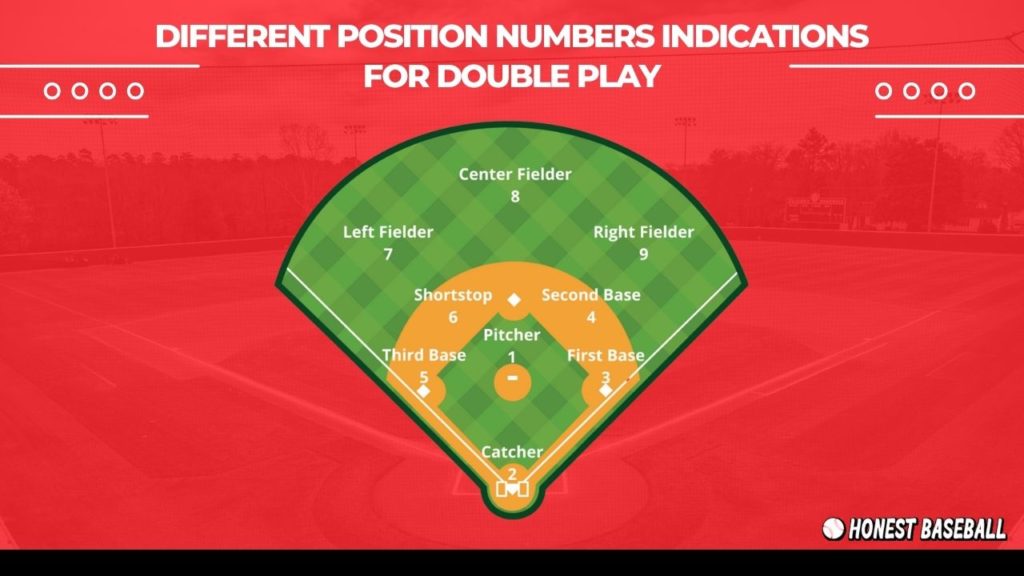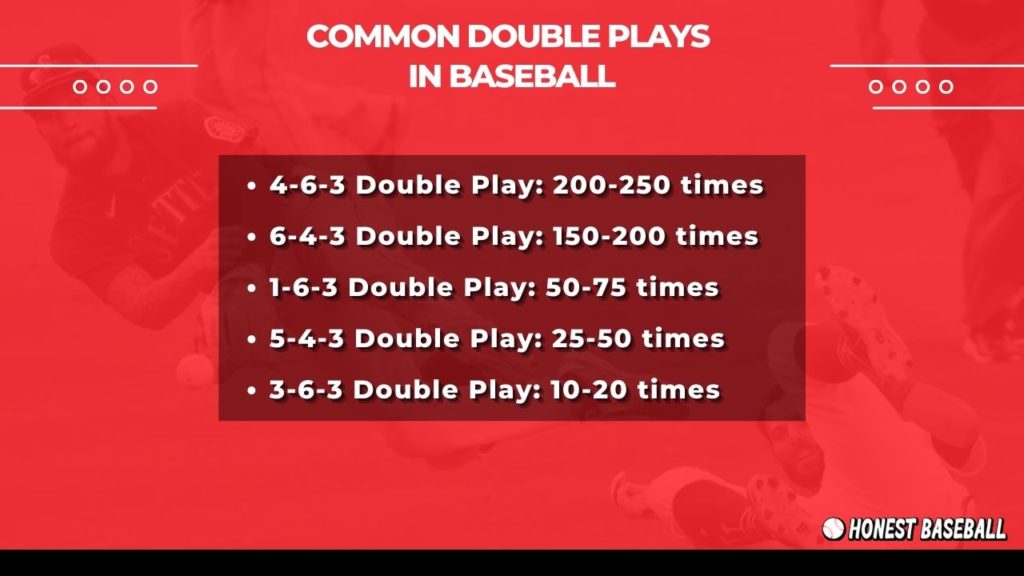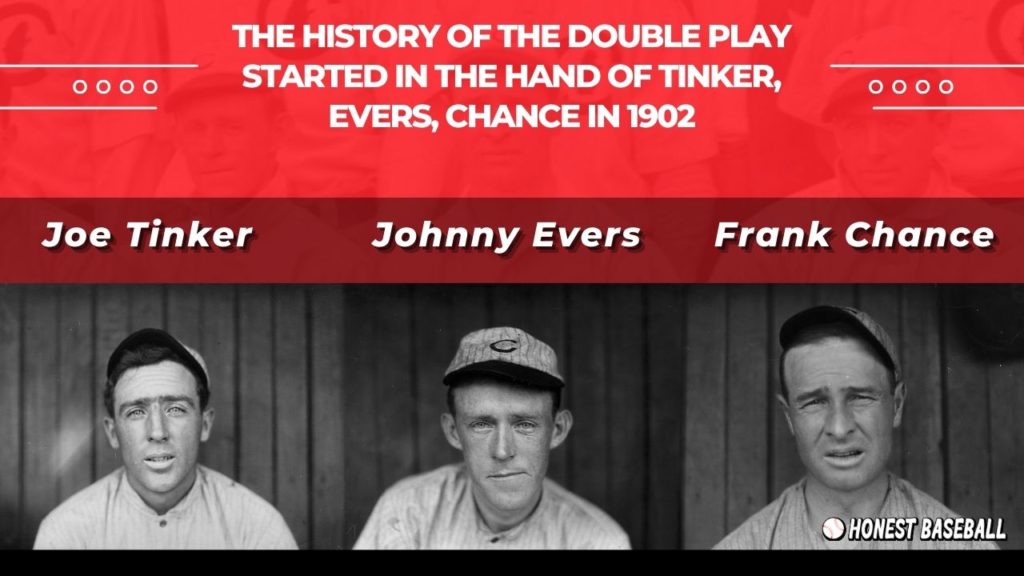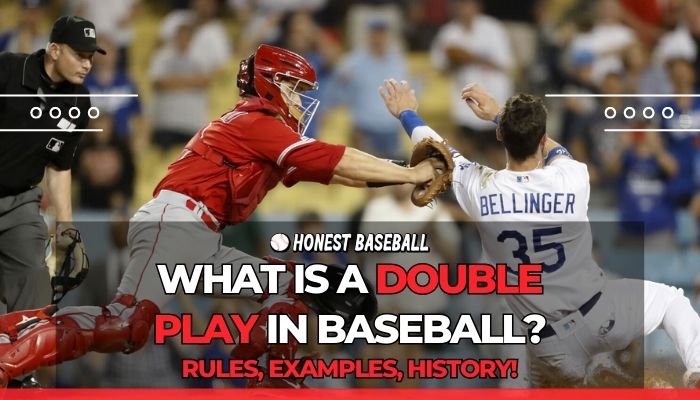Last Updated on April 12, 2023
A double play is a defensive play that results in 2 outs in a single play. However, that’s only an easy definition of this exciting gameplay.
You need to explore its history, rules, and examples to learn more about what is a double play in baseball.
The double play was first discovered in 1902 by 3 defensive players from Chicago Cubs, Joe Tinker, Johnny Evers, and Frank Chance.
Later many teams and players scored this play in the MLB record book. To count any act as double play, it should meet all the mentions in MLB Rulebook section 9.11. In this article, I’m gonna discuss more of them.
Understanding the Basics of Baseball Double Play
Double play term is used in both baseball and softball. It represents 2 outs in a single play. It’s also known as DP, twin killing, double killing, etc.
Moreover, in double plays, there are usually 3 defensive players involved. Therefore, you’ll see 3 position numbers are denoted in a double play score.
To consider an action as double play, it should meet all the conditions mentioned in MLB rule 9.11.
According to the double play rule, the scorer should acknowledge the contribution of all players who’ve participated (assisted) to make 2 outs achieved in the same play.
More specifically, these are the players who assist from pitch delivery till the ball becomes dead.
“The conditions are only applicable if there’s no error or misplay intervenes between the putouts of the players. The same rules are applicable in terms of triple play also.”
There was a survey executed in the 2016 MLB season, which showed each team achieved 145 double plays (on average).
Double Play Examples
Check out the below examples of double plays to get a practical idea about this act or score.
Example 1
Step 1: A pitcher tosses a ground ball to the hitter.
Step 2: The hitter hits the ball and it goes toward any of the infielders.
Step 3: Then the infielder throws the ball to another infielder to get the 1st force out of a baserunner.
Step 4: The second infielder then throws the ball to the 1st baseman to force out the hitter and gets another score.
Example 2
Step 1: The pitcher pitches a ball.
Step 2: Then the hitter hits the ball but the 1st baseman catches the ball, resulting in the 1st out
Step 3: Next, the baseman reaches 1st base before the runner, meaning the 2nd out is executed.
“Example 2 is a reference to the rare unassisted double play. However, instead of an infielder, an outfielder can also make a double play if replace the action by the position.”
Example 3
Step 1: The pitcher throws the ball toward the hitter
Step 2: Then the batter or hitter gets a strikeout. However, one of the runners tries to steal a base.
Step 3: But the catcher manages to throw the ball to the base fielder (any of the infielders) who steps on the base before the runner. So, another out is scored, resulting in a double play.
“These sort of double plays are called Throw ’em out or Strike ’em out as the first out is scored by the catcher.”
Positions Number Indications for Double Plays
You may have seen double plays represented by numbers such as 6-4-3, 4-6-3, etc. Each of these numbers actually represents the players’ position who were involved to execute the double play.
To understand this better, you should get an idea of the defensive player position numbers.
In baseball, each defensive player is assigned a number that helps to quickly identify the player’s position in a double play score. These numbers range from 1-9.

Pitcher (Position Number: 1)
In every double play, the pitcher is in the unavoidable position. Why?
Because after a ball is hit by the batter and fielded by a defensive player, it would be thrown back to the pitcher, at least in most cases. Therefore, in most double plays, you’ll see the pitcher’s number.
Check out: Guide to practice pitching alone to sharpen your skills.
Catcher (Position Number: 2)
Generally, the 2nd and 3rd positions are the most common catcher (2) roles in double plays. I’ve seen that typically, catchers get a strike out first, then act forward to force out any of the baserunners.
And if succeeded, it counts as a double play. A 1-2-3 double play is an example where the catcher holds the second spot.
Check out: How to train yourself to become a professional catcher.
1st Baseman (Position Number: 3)
Another common defensive player in double plays is the first baseman, which is represented by the number 3. For instance, a 6-4-3 double play implies that there’s a first baseman or infielder involved in the play at the final spot.
2nd Baseman (Position Number: 4)
Being a shield in a large defensive area (from shortstop to central outfielder), second baseman (4) also gets frequent chances to participate in double plays.
Some of the most common double plays including the second baseman are 4-6-3 and 6-4-3.
3rd Baseman (Position Number: 5)
The third baseman holds the 5th number as a defensive player. He stands at the left position of the catcher as an infielder. This guy is quite active as an Assist in baseball.
“The Assist is the defensive player who fields the ball first after being hit by the batter and then throws it to any baseman or catcher to get a force out.”
An observed double with a third baseman’s involvement is 5-4-3 where he fields the ball first, throws it to the second baseman (4), and gets the first out. Then the second base guy throws it again to the first base to force out the runner.
Shortstop (Position Number: 6)
Basically, the second baseman is considered the shortstop in baseball. This defensive position is denoted by number 6. 6-4-3 and 5-4-3 double plays are examples, which involved shortstop players.
Left Outfielder (Position Number: 7)
The left outfielder (7) is one of the 3 defensive players fielding in the outfield area. A 7-2 double play is a good example where the left fielder first catches a fly ball and gets the first out. Then he throws the ball to the catcher to force out the third baseman.
Center Fielder (Position Number: 8)
In the history of the double play, the center fielder’s involvement isn’t pretty common. One of these kinds of double plays is an 8-2 double play. It’s almost similar to the 7-2, however, replacing the left fielder with the center outfielder.
Right Fielder (Position Number: 9)
When a right outfielder (9) assists a double play, it counts the player’s position. In such double plays, the player usually tosses the ball to any of the bases to get another force after catching a fly ball. An example of this play is 9-2.
17 Types of Double Plays in Baseball
Though it’s an uncommon gaming act in baseball, there are 17 possible combinations of double plays so far witnessed. Let’s take a quick look at them:
| 17 Double Plays | Practical Example of How They Occur (Step-by-Step Walkthrough) |
| 1-2-3 | Batter hits the ball Fielded by the pitcher (1) Pitcher tosses the ball to the catcher (2)Catcher hurls it to the first baseman (3) |
| Fly Ball Out +Runner Out | Batter hits a fly ballCatcher catches the ballCatcher throws the ball to any of the basemen Gets force out |
| Strikeout + Stole Catch | Batter is strikeoutCatcher throws the ball to the base where the batter tries to tag upBaseman throws the ball to the catcher and forces out the third baserunner |
| 4-6-3 | Batter hits the ballSecond baseman (4) fields and throws it to SS (shortstop or 6)6 throws it again to the first baseman (3) |
| 3-2 | Batter hits the ballFirst baseman (3) fields the ball and tags up the base before the batterAfter the first out, he throws it to the catcher (2) |
| 3-6 | First baseman (3) catches the ball and gets the first outHe throws it to the Shortstop (6) and gets the first base runner out |
| 5-4-3 | Batter hits a ground or fly ballThird baseman (5) catches the ball5 throws it to the second baseman (4)4 throws the ball to the first baseman (3) and gets a force out |
| 3-2-3 | Batted ball drives to the first baseman (3)3 throws to the catcher (2) and gets the first force out2 throws the ball back to the 3 and gets another force out |
| 3-6-3 | Batted ball fielded by the first baseman (3)3 tosses the to the shortstop (6) and gets first out6 throws the ball to 3 again and gets the second force out |
| 5-3 | Third baseman fields a batted ball and tags up the following baseTosses the ball to the first baseman (3) and gets the final force out. |
| Fly ball + Runner Double off | While running on a fly ball, the baserunner got out, trying to make 2 runs |
| Sac-bunt | Typical line-ups: 1-5-3, 2-6-3, 3-5-4 |
| 6-4-3 | Batted ball is fielded by the shortstop (6)6 throws the ball to the second baseman (4) and gets the first out 4 throws the ball to the first baseman (3) and gets another force out |
| Line Out | Pitcher (1) catches the ball hit by the batterThen tosses the ball to the 3 or first baseman and gets the second out |
| 3-6-1 | First baseman (3) fields the batted ball3 throws the ball to the shortstop (6)6 throws the ball to the pitchers and confirms two force-outs in total |
| 4-3/6-3 + Tagged mid infielder | Second baseman (4) or shortstop (6) fields a batted ball, confirming the tag on their platesThrows the ball to the first baseman (3) and gets another out |
| 1-6-3 | Pitcher (1) catches the ball first1 throws it to the shortstop (6) and confirms first out6 throws it to the first baseman (3) and confirms another out |
What Are The Common Double Play

The fun fact is the double play itself isn’t frequent. However, considering the double play history from 1906 to 2022, some double plays occur more frequently than others.
I just went through the historical data of some of the common double plays. If considering the 162 games a season, the data shows:
- 4-6-3 Double Play: 200-250 times
- 6-4-3 Double Play: 150-200 times
- 1-6-3 Double Play: 50-75 times
- 5-4-3 Double Play: 25-50 times
- 3-6-3 Double Play: 10-20 times
So, according to this, the most common double play is 4-6-3. But it’s worth mentioning that these are just based on a few seasons. It can vary from time to time.
What Are The Rarest Double Plays
There are some rare and unusual double plays in baseball as well. Obviously, this statement can change anytime in any season as there’s no control over the timing of the double play.
However, so far, the unassisted triple play is the rarest according to the existing event data. When a single fielder gets all 3 outs in a half-inning, it’s considered an unassisted triple play.
Typically, this occurs in line drives, running toward the middle infielder while he’s tagged up to the second base and gets a force out.
Then the same fielder tags another base to get another out. And the sequence ends with the batter who’s also running towards any base.
Famous Baseball Double Plays in History: From Tinker to Evers to Chance to the 2016 World Series

Every time you wanna recall the history of double plays, you’ve to remember Joe Tinker, Johnny Evers, and Frank Chance.
This trio has shown some remarkable double plays between 1902-12 while playing for the Chicago Cubs.
During this period, they have killed a total of 491 double players, which is itself an unbreakable record in 100 baseball history.
Among them, the most recognized match was against the New York Giants in 1910. A renowned author Franklin Pierce Adams wrote a single poem to symbolize this game for the next generation. Jokes apart, this fellow was a Giants fan 😂.
Just like these, there were lots more DPs that happened in the last century. Let’s recall a few of these thrilling moments for once.
8-6-2 Double Play By New York Yankees (August 2, 1985)
During the ending part of the 7th innings
against the Chicago White Sox. Dale Berra, Luis Salazar, and Carlton Fisk made this double play, getting two consecutive forceouts of Rickey Henderson and Ozzie Guillén.
4-1-5 Double By New York Yankees (July 24, 2016)
The New York Yankees were playing this match against the San Francisco Giants. The historic rare double play was executed by Yankees’s Starlin Castro (second baseman), Chad Green (a pitcher), and Chase Headley.
9-4-2 Double Play By New York Mets (October 4, 2006)
It was the first match of the National League Division Series. The New York Mets were on the defensive side, playing against the Los Angeles Dodgers.
Russel Martin from the LAD hit a long fly ball, which was fielded by Shawn Green (right outfielder).
He threw the ball toward the catcher, Paul Lo Duca, resulting in 2 force-outs at the same base.
5-2-6-5 Double Play By (July 30, 2018)
Yeah, this was one of a kind double play cleverly executed by the Boston Red Sox against Philadelphia Phillies.
The third baseman of BRS, Eduardo Núñez, first tackles the ball and tosses it directly toward Sandy León (catcher), resulting in the first rundown.
Xander Bogaerts got the ball from Sandy and managed to out Odúbel Herrera on the other base.
This didn’t finish there! Xander threw the ball to the catcher’s plate to Nunez, causing another out of Hoskins.
3-2-5-4-2-8-6 Double Play By (September 25, 2021)
It took time for a lot of baseball fans to digest this hypnotic double play in reality by St. Louis Cardinals against Chicago Cubs.
During the 8th inning, the Cardinals made a double play where they got two outs in one play!
It was extra special because they did it in a way that’s super rare, called a “3-2-5-4-2-8-6 double play.”
Basically, the Cubs were losing by one point and had a base runner on third base. Then Rafael Ortega hit the ball to Paul Goldschmidt (first baseman).
He threw it to Yadier Molina(catcher) and they got the first out (of the third base guy)!
Next, Yadier threw the ball and after handing over the ball multiple times, finally they got another out, which ended up being a DP.
Frequently Asked Questions
Check out some of the most commonly asked questions by baseball fans, related to what is double play.
Is it a double play 2 outs?
Yes, a double play occurs when there are 2 outs in a single play.
What does 4 6 3 double play mean?
4-6-3 double play combines the action of second baseman (4), shortstop (6), and first baseman (3) respectively. That means, to execute the double play, all these players participated chronologically in this play.
What is a triple play in baseball?
Just like a double play, if 3 outs happen in a single play, it’s called a triple play. Till now, 733 triple plays or TP occurred in MLB history, considering 1876-2022.
What are the rarest double plays in baseball?
Triple play, itself, is tough to achieve. And if expecting a single player makes out of 3 play batting order players, it’s actually near impossible. Considering these factors, the unassisted triple play is the rarest double play in baseball. Check out a few of the unassisted triple plays in baseball history.
Wrapping Up
Hopefully, that answered all your query regarding what is a double play in baseball. It’s undoubtedly one of the few baseball game moments that excite the live audience. If you found this discussion helpful, please care to share what makes you curious about the double play. Type your feedback in the comments.
Check out more about baseball:
66 Years of Gold Glove Award History At a Glance
How Many Baseball Players Have 700 Home Runs – 4 Greatest Among Greats!

Hello everyone. My name is Jason Butler, and I live in California, America. I was a professional AAA Minor League Baseball player. I lost my chance of playing MLB for injury issues, but I did not lose my love for baseball. I attended the coaching training program and am now working as a coach in a small school in San Diego.
I always love to share my experience and knowledge if that can help you. Play baseball, and stay fit.
